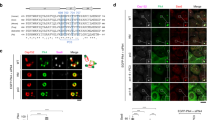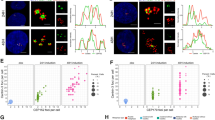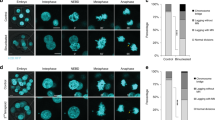Abstract
Centrosome duplication is a key requirement for bipolar spindle formation and correct segregation of chromosomes during cell division. In a manner highly reminiscent of DNA replication, the centrosome must be duplicated once, and only once, in each cell cycle. How centrosome duplication is regulated and coordinated with other cell-cycle functions remains poorly understood. Here, we have established a centrosome duplication assay using mammalian somatic cells. We show that centrosome duplication requires the activation of E2F transcription factors and Cdk2–cyclin A activity.
This is a preview of subscription content, access via your institution
Access options
Subscribe to this journal
Receive 12 print issues and online access
$209.00 per year
only $17.42 per issue
Buy this article
- Purchase on Springer Link
- Instant access to full article PDF
Prices may be subject to local taxes which are calculated during checkout






Similar content being viewed by others
References
Stearns, T. & Winey, M. The cell center at 100. Cell 91, 303–309 (1997).
Winey, M. & Byers, B. Assembly and functions of the spindle pole body in budding yeast. Trends Genet. 9, 300–304 (1993).
Paoletti, A. & Bornens, M. Organisation and functional regulation of the centrosome in animal cells. Prog. Cell Cycle Res. 3, 285–299 (1997).
Kellogg, D. R., Moritz, M. & Alberts, B. M. The centrosome and cellular organization. Annu. Rev. Biochem. 63, 639–674 (1994).
Heald, R., Tournebize, R., Habermann, A., Karsenti, E. & Hyman, A. Spindle assembly in Xenopus egg extracts: respective roles of centrosomes and microtubule self-organization. J. Cell Biol. 138, 615–628 (1997).
Boveri, T. Zur Frage der Entstehung maligner Tumoren (Fisher Verlag, Jena, 1914).
Lingle, W. L., Lutz, W. H., Ingle, J. N., Maihle, N. J. & Salisbury, J. L. Centrosome hypertrophy in human breast tumors: implications for genomic stability and cell polarity. Proc. Natl Acad. Sci. USA 95, 2950– 2955 (1998).
Pihan, G. A. et al. Centrosome defects and genetic instability in malignant tumors . Cancer Res. 58, 3974– 3985 (1998).
Kuriyama, R. & Borisy, G. G. Centriole cycle in Chinese hamster ovary cells as determined by whole-mount electron microscopy. J. Cell Biol. 91, 814–821 (1981).
Vorobjev, I. A. & Chentsov Yu, S. Centrioles in the cell cycle. I. Epithelial cells. J. Cell Biol. 93, 938–949 (1982).
Chretien, D., Buendia, B., Fuller, S. D. & Karsenti, E. Reconstruction of the centrosome cycle from cryoelectron micrographs. J. Struct. Biol. 120, 117–133 (1997).
Brinkley, B. R. Microtubule organizing centers. Annu. Rev. Cell Biol. 1, 145–172 (1985).
Kuriyama, R. & Borisy, G. G. Microtubule-nucleating activity of centrosomes in Chinese hamster ovary cells is independent of the centriole cycle but coupled to the mitotic cycle. J. Cell Biol. 91, 822–826 (1981).
Phillips, S. G. & Rattner, J. B. Dependence of centriole formation on protein synthesis. J. Cell Biol. 70, 9–19 (1976).
Sluder, G., Miller, F. J. & Rieder, C. L. The reproduction of centrosomes: nuclear versus cytoplasmic controls. J. Cell Biol. 103, 1873– 1881 (1986).
Raff, J. W. & Glover, D. M. Nuclear and cytoplasmic mitotic cycles continue in Drosophila embryos in which DNA synthesis is inhibited with aphidicolin. J. Cell Biol. 107, 2009 –2019 (1988).
Sluder, G., Miller, F. J., Cole, R. & Rieder, C. L. Protein synthesis and the cell cycle: centrosome reproduction in sea urchin eggs is not under translational control. J. Cell Biol. 110, 2025–2032 (1990).
Gard, D. L., Hafezi, S., Zhang, T. & Doxsey, S. J. Centrosome duplication continues in cycloheximide-treated Xenopus blastulae in the absence of a detectable cell cycle. J. Cell Biol. 110, 2033– 2042 (1990).
Hinchcliffe, E. H., Cassels, G. O., Rieder, C. L. & Sluder, G. The coordination of centrosome reproduction with nuclear events of the cell cycle in the sea urchin zygote. J. Cell Biol. 140, 1417–1426 (1998).
Palazzo, R. E., Vaisberg, E., Cole, R. W. & Rieder, C. L. Centriole duplication in lysates of Spisula solidissima oocytes [erratum Science 256, 1746 (1992)]. Science 256, 219–221 (1992).
Tournier, F., Cyrklaff, M., Karsenti, E. & Bornens, M. Centrosomes competent for parthenogenesis in Xenopus eggs support procentriole budding in cell-free extracts. Proc. Natl Acad. Sci. USA 88, 9929–9933 (1991).
Hinchcliffe, E. H., Li, C., Thompson, E. A., Maller, J. L. & Sluder, G. Requirement of Cdk2-cyclin E activity for repeated centrosome reproduction in xenopus egg extracts. Science 283, 851–854 (1999).
Fukasawa, K., Choi, T., Kuriyama, R., Rulong, S. & Van de Woude, G. F. Abnormal centrosome amplification in the absence of p53. Science 271, 1744– 1747 (1996).
Zhou, H. et al. Tumour amplified kinase STK15/BTAK induces centrosome amplification, aneuploidy and transformation. Nature Genet. 20, 189–193 (1998).
Lacey, K. R., Jackson, P. K. & Stearns, T. Cyclin-dependent kinase control of centrosome duplication . Proc. Natl Acad. Sci. USA 96, 2817– 2822 (1999).
Balczon, R. et al. Dissociation of centrosome replication events from cycles of DNA synthesis and mitotic division in hydroxyurea-arrested Chinese hamster ovary cells. J. Cell Biol. 130, 105– 115 (1995).
Lukas, J. et al. Retinoblastoma-protein-dependent cell-cycle inhibition by the tumour suppressor p16. Nature 375, 503– 506 (1995).
Weinberg, R. A. The retinoblastoma protein and cell cycle control. Cell 81, 323–330 (1995).
Lukas, J. et al. Cyclin E-induced S phase without activation of the pRb/E2F pathway . Genes Dev. 11, 1479–1492 (1997).
Wang, J. Y. Retinoblastoma protein in growth suppression and death protection. Curr. Opin. Genet. Dev. 7, 39–45 (1997).
Dyson, N. The regulation of E2F by pRB-family proteins. Genes Dev. 12, 2245–2262 (1998).
Wu, C. L., Classon, M., Dyson, N. & Harlow, E. Expression of dominant-negative mutant DP-1 blocks cell cycle progression in G1. Mol. Cell. Biol. 16, 3698–3706 ( 1996).
Qin, X. Q., Livingston, D. M., Kaelin, W. G., Jr & Adams, P. D. Deregulated transcription factor E2F-1 expression leads to S-phase entry and p53-mediated apoptosis. Proc. Natl Acad. Sci. USA 91 , 10918–10922 (1994).
Wu, X. & Levine, A. J. p53 and E2F-1 cooperate to mediate apoptosis. Proc. Natl Acad. Sci. USA 91, 3602–3606 (1994).
Kowalik, T. F., DeGregori, J., Schwarz, J. K. & Nevins, J. R. E2F1 overexpression in quiescent fibroblasts leads to induction of cellular DNA synthesis and apoptosis. J. Virol. 69, 2491–2500 (1995).
van den Heuvel, S. & Harlow, E. Distinct roles for cyclin-dependent kinases in cell cycle control. Science 262, 2050–2054 (1993).
Pagano, M. et al. Regulation of the cell cycle by the cdk2 protein kinase in cultured human fibroblasts. J. Cell Biol. 121, 101–111 (1993).
Polyak, K. et al. Cloning of p27Kip1, a cyclin-dependent kinase inhibitor and a potential mediator of extracellular antimitogenic signals. Cell 78, 59–66 ( 1994).
Toyoshima, H. & Hunter, T. p27, a novel inhibitor of G1 cyclin-Cdk protein kinase activity, is related to p21. Cell 78 , 67–74 (1994).
Knudsen, E. S., Buckmaster, C., Chen, T. T., Feramisco, J. R. & Wang, J. Y. Inhibition of DNA synthesis by RB: effects on G1/S transition and S-phase progression. Genes Dev. 12, 2278–2292 ( 1998).
Stoeber, K. et al. Cdc6 protein causes premature entry into S phase in a mammalian cell-free system. EMBO J. 17, 7219– 7229 (1998).
Koff, A. et al. Formation and activation of a cyclin E-cdk2 complex during the G1 phase of the human cell cycle. Science 257, 1689–1694 (1992).
Dulic, V., Lees, E. & Reed, S. I. Association of human cyclin E with a periodic G1-S phase protein kinase. Science 257, 1958–1961 ( 1992).
Helin, K. Regulation of cell proliferation by the E2F transcription factors. Curr. Opin. Genet. Dev. 8, 28–35 (1998).
Hateboer, G. et al. Cell cycle-regulated expression of mammalian CDC6 is dependent on E2F. Mol. Cell. Biol. 18, 6679– 6697 (1998).
Yan, Z. et al. Cdc6 is regulated by E2F and is essential for DNA replication in mammalian cells. Proc. Natl Acad. Sci. USA 95, 3603–3608 (1998).
Ohtani, K., DeGregori, J. & Nevins, J. R. Regulation of the cyclin E gene by transcription factor E2F1. Proc. Natl Acad. Sci. USA 92, 12146–12150 (1995).
Schulze, A. et al. Cell cycle regulation of the cyclin A gene promoter is mediated by a variant E2F site. Proc. Natl Acad. Sci. USA 92 , 11264–11268 (1995).
Strausfeld, U. P. et al. Both cyclin A and cyclin E have S-phase promoting (SPF) activity in Xenopus egg extracts. J. Cell Sci. 109, 1555–1563 (1996).
Fry, A. M., Meraldi, P. & Nigg, E. A. A centrosomal function for the human Nek2 protein kinase, a member of the NIMA-family of cell cycle regulators. EMBO J. 17, 470–481 (1998).
Acknowledgements
We thank Y.-D. Stierhof for the electron microscopic data in Fig. 1, N. Roggli for help with artwork, and several colleagues for kind gifts of plasmids, particularly E. Harlow for Cdk1, 2 and 3, J. Massagué for p27Kip1, S. Reed for cyclin E , J. Pines for cyclin A , C.-L. Wu for DP1, and K. Helin for E2F. We also thank B. Amati as well as all members of the laboratory for stimulating discussions. This work was supported by grants from the Swiss National Science Foundation, the Swiss Cancer League, the Human Frontier Science Program and the Canton of Geneva.
Correspondence and requests for materials should be addressed to E.A.N.
Author information
Authors and Affiliations
Corresponding author
Rights and permissions
About this article
Cite this article
Meraldi, P., Lukas, J., Fry, A. et al. Centrosome duplication in mammalian somatic cells requires E2F and Cdk2–Cyclin A. Nat Cell Biol 1, 88–93 (1999). https://doi.org/10.1038/10054
Received:
Revised:
Accepted:
Published:
Issue Date:
DOI: https://doi.org/10.1038/10054
This article is cited by
-
Epigenetic alterations impede epithelial-mesenchymal transition by modulating centrosome amplification and Myc/RAS axis in triple negative breast cancer cells
Scientific Reports (2023)
-
p53 mitotic centrosome localization preserves centrosome integrity and works as sensor for the mitotic surveillance pathway
Cell Death & Disease (2019)
-
Mild replication stress causes chromosome mis-segregation via premature centriole disengagement
Nature Communications (2019)
-
Absence of cyclin-dependent kinase inhibitor p27 or p18 increases efficiency of iPSC generation without induction of iPSC genomic instability
Cell Death & Disease (2019)
-
A novel WDR62 missense mutation in microcephaly with abnormal cortical architecture and review of the literature
Journal of Applied Genetics (2019)



